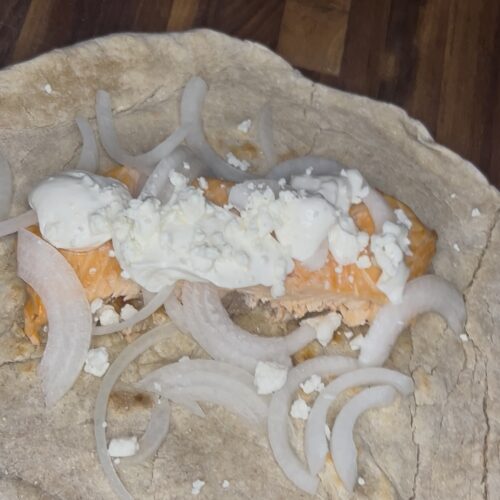This isn’t your average lunch wrap—it’s a bite of Viking history wrapped in flatbread and powered by protein. Inspired by the foodstuffs consumed by Norse warriors, farmers, and seafarers alike, this Viking Warrior’s Snackwrap features salted baked salmon (hertir fiskr), barley-rye flatbrød, tangy skyr sauce, raw onions, and goat cheese. It’s not only delicious—it’s historically grounded, drawing on ingredients verified by Viking-age archaeological finds and Old Norse texts.
While no Viking ever walked into a longhouse and ordered a “snackwrap,” the individual elements of this dish are all authentic to the Viking diet. This modern format simply unites them in a convenient, protein-rich handheld form—a perfect fusion of historical accuracy and culinary creativity.
The Authentic Components of the Wrap
🐟 Salted Salmon (Hertir Fiskr)
Vikings were masters of food preservation, especially when it came to fish. Living in coastal regions and seafaring by trade, Norse people relied heavily on seafood, particularly salmon, herring, and cod. They developed effective methods of salting, drying, and fermenting fish to preserve it for long winters and longships. Archaeological remains of fish and fish processing equipment have been found in settlements like Borg in Lofoten, Gokstad, and Kaupang, with evidence of both inland and coastal trade in salted fish. In Old Norse, the term hertir fiskr (literally “hardened fish”) referred to preserved fish—an essential source of protein and calories in the Norse diet.
This type of preserved fish was practical for both peasant households and Viking raiding parties. In fact, finds from the Gokstad ship burial (c. 900 CE) include preserved food provisions—likely intended for the warrior’s journey into the afterlife.
🌾 Barley and Rye Flatbrød
Bread in the Viking Age was nothing like the fluffy loaves we know today. Instead, flatbrød—thin, hard flatbread—was the staple. Made from coarsely ground barley or rye, it was often baked over stones or griddles. These grains were commonly grown across Scandinavia, as evidenced by archaeobotanical studies from farming settlements like Hedeby, Jorvik, and Birka. Barley was especially hardy in the cold northern climates and had been cultivated in Norway since the Bronze Age.
Flatbrød was perfect for a mobile lifestyle—it could be stored for months, didn’t mold easily, and doubled as a plate. During raids or travel, Vikings would often scoop meat, cheese, or fish onto a piece of flatbread and eat it by hand. This portability and durability make flatbrød the perfect base for our modern reinterpretation.
🥣 Skyr: Viking Yogurt
Skyr is a cultured dairy product dating back to the Viking Age, especially in Iceland, where it remains a national staple. Brought from Norway by Norse settlers in the 9th century, skyr was a crucial part of the dairy-rich Viking diet. It was high in protein, low in fat, and easily made using natural fermentation. Archaeological digs at farmsteads such as Stöng (Iceland) and Borg (Norway) confirm the presence of dairy production facilities—often with clay vessels containing residues from cheese or skyr-like products.
Though Vikings didn’t likely flavor their skyr with mustard and onion powder, they were no strangers to herbs and alliums. Wild onions, garlic, and even native mustard plants grew throughout northern Europe and were likely used in cooking and food preservation. This modern skyr sauce is a flavorful nod to those historic roots.
🧅 Raw Onion and Goat Cheese
Onions were widely cultivated in Viking-age Scandinavia and the British Isles. Finds from Dublin, York, and Denmark show onion bulbs among kitchen waste, confirming their culinary use. Eaten raw, cooked, or preserved, onions provided important nutrients and pungent flavor.
As for goat cheese (geitost), goats were commonly kept by Norse households, especially in rocky or mountainous areas unsuitable for cattle. Goats were hardy animals, and their milk was often used to make cheese that could be dried or aged. Cheese was even part of tribute payments and food taxes collected by chieftains in medieval Norse societies, according to law codes like Grágás (Icelandic law texts from the 12th century).
If you like this recipe and want an e-book of 50 more just like it, check out Eating with Empires!
The Recipe: Viking Warrior’s Snackwrap

Viking Salmon & Skyr Flatbread
Ingredients
For the Wrap:
- 1 large salmon fillet 8–10 oz
- Coarse salt for curing
- Fresh cracked pepper
- Olive oil optional
For the Flatbrød:
- ½ cup barley flour
- ½ cup rye flour
- ¼ tsp salt
- ½ cup warm water
For the Skyr Sauce:
- 3 tbsp skyr
- ¼ tsp salt
- ½ tsp mustard powder
- ½ tsp onion powder
Toppings:
- 2 tbsp crumbled goat cheese
- A few slices of raw onion
Instructions
Cure and Bake the Salmon
- Rub the salmon with coarse salt and pepper. Let it rest in the fridge for at least 1 hour. Preheat oven to 375°F (190°C), then bake for 15–20 minutes or until flaky. Let cool slightly.
Make the Flatbrød
- Combine flours and salt in a bowl. Add warm water gradually until a firm dough forms. Roll out thin and cook in a dry skillet for 2–3 minutes per side until dry and lightly browned.
Prepare the Skyr Sauce
- Mix skyr with salt, mustard powder, and onion powder. Stir until smooth.
Assemble the Wrap
- Lay flatbrød down, spread skyr sauce over it, add flaked salmon, sprinkle crumbled goat cheese, and top with raw onion slices. Roll or fold as desired.
Notes
- Make-Ahead Tip: You can cure and bake the salmon ahead of time and store it in the fridge for up to 2 days. It actually tastes better slightly chilled when paired with the skyr sauce.
- Flatbrød Texture: For a more traditional Viking-style bread, keep the flatbrød thin and cook it until it’s slightly crisp and dry—it was meant to last on long voyages.
- Customize Your Skyr Sauce: While mustard and onion powder are flavorful modern additions, you can also experiment with crushed herbs like thyme or wild garlic for an earthier, more historically grounded twist.